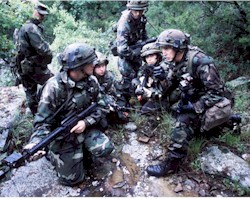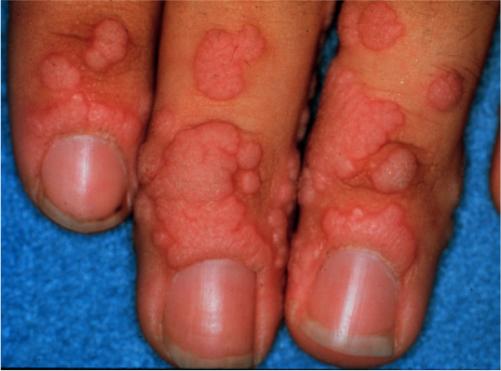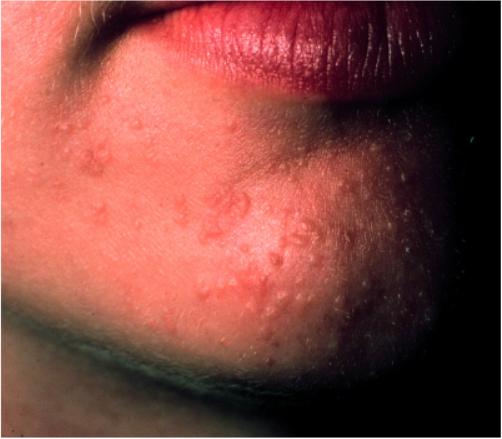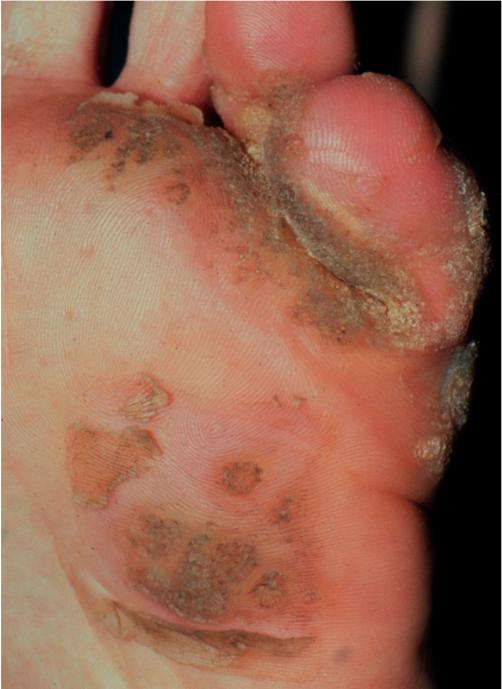Verrucae
|
Everybody dislikes
warts. Warts are a challenge for both you as well as your patient.
Remember that the family of wart viruses is a lot smarter than we
are. Even after the wart is visibly gone, virus persists in the skin
and may recur later. Make sure that both you
and your patient have realistic expectations for treatment. Your goal
is to minimize your patient's morbidity and encourage the immune
system to control the infection. Permanently ridding your patient of
the wart virus is not possible. Overly aggressive therapy is usually
only rewarded with extra morbidity and is frequently not more likely
to be successful. Warts are passed
between humans commonly in "communal" settings such as berthing
compartments, recreational facilities, and equipment. Wear shower
shoes, T-shirts, and weight lifting gloves to avoid exposure and the
spread of warts to others. The most common
encountered morbidity from warts (especially on the feet) is pain.
The pain is not caused by the wart itself, but rather by the mass
effect of having a hard knot within and on top of the skin. Gently
paring the wart with a scalpel blade just barely to the point of
pinpoint bleeding is an easy way to debulk it, thereby decreasing the
patient's discomfort as well as preparing the site for other
treatment. Control any bleeding by applying Monsell's solution or 20%
Aluminum chloride solution (DrySol). Common treatments for
warts whether chemical, electrical, or surgical are skin destructive
in nature. Chemical salicylic acid
wart varnishes (e.g. Duofilm, Occlusal HP, Compound W, etc.) should be
applied to the wart daily, preferably at bedtime. Consider protecting
the surrounding normal skin by applying petrolatum. Place two or
three coats on the wart, allowing each coat to dry; then apply a
bandaid. Salicylic acid plasters (e.g. Mediplast) should be cut to
fit the wart and then applied at bedtime and overlaid with a bandaid.
The next day, the lesion can be pared or abraded with an Emory board
or pumice stone. Stop treatment if there is substantial pain,
irritation, or ulceration. Trichloroacetic acid
solution (TCA) can be used similar to the salicylic acid preparations,
but has a larger potential for tissue destruction. Use it with
respect. Liquid nitrogen, if
applied optimally, will induce a small blister allowing the wart to
peel away from the underlying dermis. Freeze the wart quickly to the
point of turning it white with a 1 mm zone of normal skin. A good
method to minimize the damage to surrounding normal skin is to apply
an appropriately sized otoscope speculum and spray the nitrogen
through the open end. Let the wart thaw slowly, then repeat the
freeze. After freezing, the
lesion will follow this sequence over the next few days: pink, red,
purple, brown, and then maybe even black. A blister will likely form
and should be approached as any other blister. Once the vesicle has
opened and dried, pare off any remainder and see if any lesion
remains. Repeat treatment should be considered every 1-2 weeks or so
if any lesion remains. Electrosurgery should
be used only if you have had some training in its use. It can
generate a fair degree of post-operative morbidity. Areas over
joints, near the nails, or over the bony prominences are particularly
difficult to treat. Chemical vesicants such as
cantharidin are quite destructive and are not recommended as initial
therapy.
|
Written and revised by CAPT Dennis A. Vidmar, MC, USN, Department of Military and Emergency Medicine, and Department of Dermatology, Uniformed Services University of the Health Sciences, Bethesda, MD (1999). Additional images provided by CAPT Vidmar in June, 2000, subsequent to the initial publication of this manual. |
Preface · Administrative Section · Clinical Section
The
General Medical Officer Manual , NAVMEDPUB 5134, January 1, 2000
Bureau
of Medicine and Surgery, Department of the Navy, 2300 E Street NW, Washington, D.C.,
20372-5300
This web version of The General Medical Officer Manual, NAVMEDPUB 5134 is provided by The Brookside Associates Medical Education Division. It contains original contents from the official US Navy version, but has been reformatted for web access and includes advertising and links that were not present in the original version. This web version has not been approved by the Department of the Navy or the Department of Defense. The presence of any advertising on these pages does not constitute an endorsement of that product or service by either the Department of Defense or the Brookside Associates. The Brookside Associates is a private organization, not affiliated with the United States Department of Defense. All material in this version is unclassified. This formatting © 2006 Medical Education Division, Brookside Associates, Ltd. All rights reserved.
Home · Textbooks and Manuals · Videos · Lectures · Distance Learning · Training · Operational Safety · Search
|
|
|
This website is dedicated to the development and dissemination of medical information that may be useful to those who practice Operational Medicine. This website is privately-held and not connected to any governmental agency. The views expressed here are those of the authors, and unless otherwise noted, do not necessarily reflect the views of
the Brookside Associates, Ltd., any governmental or private organizations. All writings, discussions, and publications on this website are unclassified.
© 2006 Medical Education Division, Brookside Associates, Ltd. All rights reserved
Other Brookside Products



